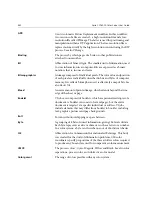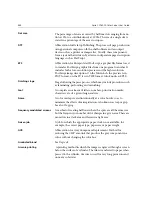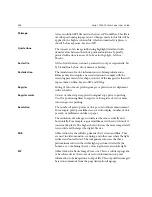
490
Spire CXP6000 Color Server User Guide
Spot color
An additional separation (fifth, or more) that is used with special inks
to achieve difficult color combinations, such as gold, or chocolate
brown. Spot color is sometimes used by graphic artists to define
special corporate colors, for example, for company logos. On the
CXP6000 Color Server, spot colors are tanslated into CMYK values
using a dictionary, that can be edited to adjust CMYK values.
Step and repeat
The procedure of copying the same image by stepping it in position
both horizontally and vertically according to a predetermined layout.
Stochastic screening
A method of creating frequency-modulated halftones that depends
on the number of laser dots in a given area rather than the size of the
laser dots in a given area. The dots are randomly placed and very
small. Areas with a higher dot percent have more spots exposed in
that area and those with a low dot percent have fewer spots. Stochastic
screening is used to eliminate moiré and improve picture detail and
sharpness in high-end color printing.
Subtractive color model
A color process in which the red, green and blue components of the
original subject are reproduced as three super-imposed images in the
complementary (subtractive) colors of cyan, magenta and yellow
respectively. See also
CMYK
,
Process colors
,
Additive color model
.
Three quartertone
Tone area of an image influencing the shadow detail and with density
values between the Midtone and the Dark Point. Typically printed
with a dot area near 75%.
Three quartertone
Tone area of an image influencing the shadow detail and with density
values between the Midtone and the Dark Point. Typically printed
with a dot area near 75%.
Tone compression
The reduction of the density range of an original to the density range
achievable in the reproduction.
Tone reproduction curve
A graph showing the density of each point of the original and its
corresponding density on the reproduction.
Trapping
Creating and overlap (spread) or an underlap (choke) between colors
that adjoin each other to hide misregistration during printing.
Trapping is sometimes referred to as spreads and chokes, or fatties
and skinnies.
Содержание CXP6000 Color Server
Страница 2: ...This page is intentionally left blank...
Страница 3: ...Spire CXP6000 color server version 4 0 User Guide...
Страница 4: ...This page is intentionally left blank...
Страница 8: ...This page is intentionally left blank...
Страница 28: ...This page is intentionally left blank...
Страница 99: ...Spire Web Center 85 Links The Links page enables you to link to related vendors or products...
Страница 169: ...Basic Workflows Importing and Printing Jobs 156 Reprinting Jobs 158 Basic Settings 159...
Страница 174: ...160 Chapter 4 Basic Workflows No of Copies Enter the Number of Copies to be printed Print Range...
Страница 177: ...Basic Settings 163 Print Order Set the print order to From 1 to N front to back or From N to 1 back to front...
Страница 182: ...168 Chapter 4 Basic Workflows Rotate 180 To rotate your job by 180 select Yes Gallop...
Страница 190: ...176 Chapter 4 Basic Workflows Coating Select Coated to print on coated paper...
Страница 244: ...This page is intentionally left blank...
Страница 326: ...This page is intentionally left blank...
Страница 327: ...Color Workflow Calibration 314 Default Color Flow 340 Color Tools 358...
Страница 391: ...Graphic Arts Workflow Printing PrePress Files GAP Files 378 Preflight Check 380 Export as Creo Synapse InSite Job 385...
Страница 416: ...This page is intentionally left blank...
Страница 473: ...Reinstalling the System 459 10 Click Next in Step 2 Recovery window The View Configuration window appears 11 Click Close...
Страница 476: ...462 Chapter 10 System Administration Setting the Language Select the required interface language and click Next...
Страница 494: ...This page is intentionally left blank...
Страница 506: ...This page is intentionally left blank...
Страница 514: ...This page is intentionally left blank...











































